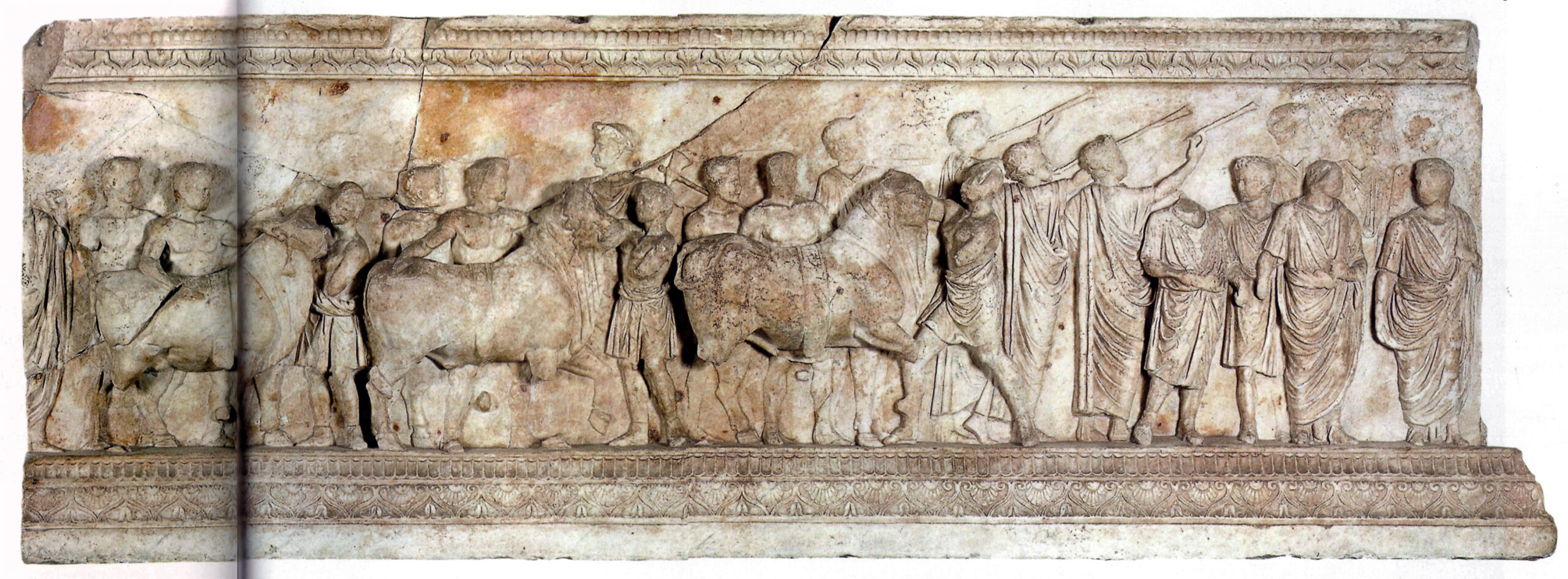Sulla’s funeral pompe
| TITLE: |
| Sulla’s funeral pompe |
| DATE: |
| 78 BC |
| TEXT: |
| MENDELSSOHN, L. (1879-1881): Appiani Historia romana, Alterum Appian’s Roman History, vol. II, Bibliotheca Teubneriana,Lipsiae: App. BC 1.105-106 |
| EDITIONS/TRANSLATIONS: |
WHITE, H, H. (1899): The Roman history of Appian of Alexandria, vol II. The Civil Wars, The Macmillan Company, New York-London SANCHO ROYO, A. (1985): Apiano. Historia Romana II. Guerras Civiles, libros I-II. Gredos, Madrid |
| KEYWORDS: |
| Word used to mean procession: |
| ἐπὶ πομπῇ(App. BC 1.105:τῶν μὲν ἄγειν ἀξιούντων τὸ σῶμα διὰ τῆς Ἰταλίας ἐπὶ πομπῇ,bring the remains of Sulla in a procession through Italy; App.BC 1.106) παραπομπήν (App. BC 1.105) |
| Words used to mean the cult images: |
| κλίνη (couch or bed where the corpse was carried, App. BC 1.105, ἐπὶ κλίνης χρυσηλάτου) λέχος (funeral litter, couch or bed, but it was usually employed for marriage, App. BC 1.106) |
| Gods or other entities named: |
| Description of the cult images: |
| “It would be impossible to describe all the splendid things contributed to this funeral” (App. BC 1.106, ἄλλη τε τῶν ἐς τῆν ταφὴν πεμφθέντων οὐ δυνατὴ φράσαι πολυτέλεια) |
| Procession’s route: |
| Funeral procession through different Italian cities (App. BC 1.105, διὰ τῆς Ἰταλίας ἐπὶ πομπῇ) towards Rome, where the remains were borne through the streets (App. BC 1.106). Finally, the corpse was shown in the forum on the rostra (public funeral orations) and then members of the Senate took up the litter and carried it to the Campus Martius (τὸ Ἄρειον), where the army coursed around the funeral pile (App. BC 1.106) |
| Frequency with which the procession takes place: |
| Performers: |
| All the priests and priestesses escorted the remains, each in proper costume (App. BC 1.106, ἱερέες τε ἅμα πάντες καὶ ἱέρειαι, κατὰ σφᾶς αὐτῶν ἑκάτεροι) The entire Senate and the whole body of magistrates attended with their insignia of office (App. BC 1.106, καὶ ἡ βουλὴ πᾶσα καὶ αἱ ἀρχαί, τὰ σφέτερα σημεῖα ἐπικείμενοι) |
| References to the public attending the procession: |
Musicians and horsemen in great numbers went in advance and a great multitude of armed men followed on foot (App. BC 1.105, σαλπιγκταί τε πολλοὶ καὶ ἱππέες καὶ ἄλλος ὅμιλος ἐκ ποδὸς ὡπλισμένος εἵπετο) and each one was assigned his place in due order as he came (App. BC 1.105, ὡς ἕκαστος ἀφικνοῖτο, εὐθὺς ἐς κόσμον καθίσταντο) Unprecedented crowd from everywhere (App. BC 1.105, ἄλλο τε πλῆθος, ὅσον ἐπ᾽ οὐδενὶ ἔργῳ, συνέτρεχεν) In the city of Rome the procession was enormous (App. BC 1.106, μετὰ πομπῆς ἐνταῦθα δὴ μάλιστα ὑπερόγκου) A multitude of the Roman knights followed with their peculiar decorations, and, in their turn, all the legions that had fought under him (App. BC 1.106, κόσμῳ δ᾽ ἄλλῳ τὸ τῶν καλουμένων ἱππέων πλῆθος εἵπετο καὶ ὁ στρατὸς ἐν μέρει πᾶς, ὅσος ὑπεστράτευτο αὐτῷ) with gilded standards and silver-plated shields (App. BC 1.106, σημεῖά τε φέροντες ἐπίχρυσα καὶ ὅπλα ἐπὶ σφίσι περιάργυρα) Countless number of trumpeters (App. BC 1.106) |
| Rites related to the procession: |
Sulla’s remains were exhibited in the Roman forum and he was given a public funeral (App. BC 1.105, καὶ ἐς τὴν Ῥώμην ἐν ἀγορᾷ προτιθέναι καὶ ταφῆς δημοσίας ἀξιοῦν) |
| Allusions to conduct or forms of reverence: |
The musicians played lamentations and loud cries were raised and they were sung by the Senate, then by the knights, then by the soldiers, and finally by the rest of the people of the procession (App. BC 1.106, παρὰ μέρος ὑγρότατα καὶ πένθιμα μελῳδούντων. βοῇ δ᾽ ἐπευφήμουν) |
| Other remarkable elements: |
Cf. Bömmer 1952: “Eine Vermischung der griechischen Heroen-Pompe und der römischen Pompe funebris”.Sulla’s corpse was borne through Italy on a golden litter with royal splendor (App. BC 1.105, καὶ ἐφέρετο ὁ νέκυς ὁ τοῦ Σύλλα διὰ τῆς Ἰταλίας ἐς τὸ ἄστυ ἐπὶ κλίνης χρυσηλάτου καὶ κόσμου βασιλικοῦ) The standards and the fasces (σημεῖα καὶ πελέκεις) that he had used while living and ruling were borne in the procession (App. BC 1.105) More than 2000 golden crowns, the gifts of cities, of the legions and of individual friends were carried in it (App. BC 1.106, στέφανοί τε γὰρ δισχιλίων πλείους ἀπὸ χρυσοῦ …, δῶρα τῶν πόλεων καὶ τῶν ὑπ᾽ αὐτῷ στρατευσαμένων τελῶν καὶ καθ᾽ ἕνα τῶν φίλων) |
| BIBLIOGRAPHY: |
BÖMMER (1952), RE: s.v. Pompa. Herrscher, vol. XXI.2, p. 1972, n.338 SUMI, G. S. (2002): “Spectacles and Sulla’s public image”, Historia: Zeitschrift Für Alte Geschichte 51.4, pp. 414–432 |
